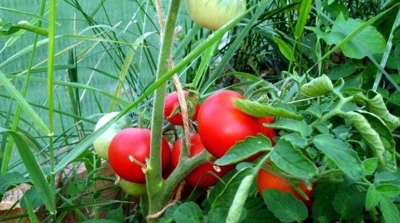
- Authors: FGBNU 'FEDERAL SCIENTIFIC CENTER OF VEGETABLES'
- Year of approval: 1950
- Category: grade
- Growth type: determinant
- Appointment: fresh consumption, for pickling and canning, for ketchup and tomato paste
- Ripening period: mid-early
- Ripening time, days: 105-110
- Growing conditions: for open ground, for film greenhouses
- Bush height, cm: 35-45
- Bush characteristic: upright
For planting on the site, you can choose small-sized tomatoes, which are easy to care for and require the installation of trellises. Tomato Alpatieva 905A is one of these varieties with abundant foliage and erect bushes.
Description of the variety
This variety belongs to the determinant, the height of the bush is from 35 to 45 centimeters. The foliage of Alpatiev 905A is strong, the first inflorescence is laid between the 6th and 8th leaves. The stalk has an articulation. The foliage is recognizable by its dark green hue and strong crinkling. Her size is average.
The main qualities of the fruit
The fruits of Alpatiev 905A are suitable for fresh consumption, they are also used to prepare ketchup, a good tomato paste. They are also used canned.
When the tomatoes are fully ripe, they are red in color, weighing from 60 to 80 grams. Tomatoes Alpatiev 905A have a flat-round shape, there is a slight ribbing. Tomatoes in this variety have excellent cracking resistance.
Taste characteristics
Juicy pulp is hidden under the smooth skin. By density, the pulp can be estimated as medium. The taste is good, balanced.
Ripening and fruiting
Tomato Alpatieva 905A belongs to medium early varieties. Its fruits ripen in 105-110 days, harvesting begins at the end of June.
Yield
The yield of the described variety is estimated as follows: 6-8 kg / m2, 146-445 kg / ha. Thus, this variety is classified as a high-yielding variety.
The timing of planting seedlings and planting in the ground
By mid-March, they begin to sow seeds for seedlings. In mid-May, the sprouts are planted under a film, and at the beginning of June they can already be transferred to open ground.

Growing tomato seedlings is an extremely important process, because it largely depends on whether the gardener can harvest at all. All aspects must be taken into account, from seedbed preparation to planting in the ground.
Landing scheme
A distance of 40 cm should be left between the tomatoes, 50 between the rows.

Growing and caring
Variety Alpatieva 905A can be successfully grown not only in greenhouses, but also in open ground, the main thing is to plant seedlings after the last frost. Due to the small size of the bushes, there is no need for tying. Also, Alpatiev 905A is not stepchild or formed.
Choose a planting site in the open sun.It is advisable to determine the pH level of the soil. If it is not suitable for planting tomatoes, it can be changed by placing the necessary substances in the ground in the fall.
In addition, tomato Alpatiev 905A responds well to fertilizers. Experienced growers use ready-made compost, seasoned manure, sphagnum peat, dry grass clippings or finely crushed plant material. Complex fertilizers are considered a good option, which are applied to the soil a few weeks before planting a tomato. It is worth using top dressing with the formula 8-32-16 or 6-24-24, avoiding ammonia fertilizers.




A plant needs different micronutrients at each stage of growth. All fertilizers can be divided into two groups: mineral and organic. Folk remedies are often used: iodine, yeast, bird droppings, eggshells.
It is important to observe the rate and period of feeding. This also applies to folk remedies and organic fertilizers.
Disease and pest resistance
Alpatiev 905A tomatoes are susceptible to fungal, bacterial and viral diseases. Fighting disease can be difficult. Disease prevention is the best course of action for an experienced grower. The first thing a grower should do is keep the area clean. There should be no plant residues, weeds.
In the spring, after the seedlings have been planted in the ground, they must be treated with copper sulfate, neem oil, and garlic infusion. If the first remedy helps to cope with some fungal diseases, then the other two will prevent insects from attacking the tomato. Fungicides based on sulfur and copper help well against diseases.


Growing regions
On the territory of our country, there are many regions where Alpatieva 905A is grown in greenhouses and on plots.
These include:
- Northwestern;
- Central;
- Volgo-Vyatsky;
- Ural;
- East Siberian regions.

























































































